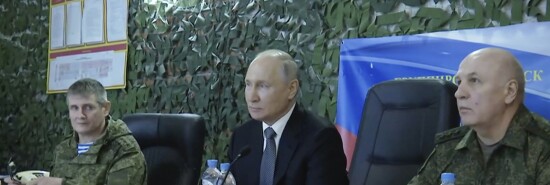
Russia mobilization rhetoric hints at shift to static defense strategy
Tom Rogan
Video Embed
Suffering vast and unanticipated losses in his Ukraine war effort, Russian President Vladimir Putin last year ordered a mobilization draft of 300,000 conscripts. Another draft had been anticipated for this year. Speaking on Tuesday, however, Putin’s spokesman Dmitry Peskov told Russian media that “there is no talk of a second wave of mobilization in the Kremlin.”
There are two likely explanations for what’s going on here.
WHY IS THE BIDEN ADMINISTRATION HELPING TRAFIGURA MAKE MONEY FOR A KREMLIN KINGPIN
The first is that Peskov is lying and a second mobilization is actively being prepared. In that case, the Kremlin’s deceptive rhetoric would reflect a growing concern over the heavy losses already sustained and its associated concern as to whether a new draft might lead to growing domestic frustration.
The second possibility is that Putin has decided, at least for the near term, to adopt a static defensive strategy in Ukraine. This seems the more likely option in the context of the current state of Russia’s war effort.
To be sure, the heavy casualties suffered by Russian ground forces and mercenary forces such as the Wagner Group mean that Russia is badly short of troops. Underlining the Kremlin’s concern over rampant draft-dodging, a law has just been introduced that makes electronic draft orders just as binding as postal or personally delivered draft orders. But the shortage of trained troops is only one problem among many for the Russian military.
For one, ammunition stocks (particularly of artillery shells and missiles) are running low. Armored forces and mobile infantry vehicles are also in short supply, and those that remain tend to be of poor quality due to inadequate or nonexistent maintenance. Tensions over supply access have rippled into the public, most notably between Wagner Group commander Yevgeny Prigozhin and the Russian general staff. Yet at the most basic level, Russian troops, particularly conscripts, also lack sufficient equipment in terms of clothing, weapons, and support infrastructure. This doesn’t simply limit the combat potential of Russian ground forces against their far-better-equipped and led Ukrainian counterparts — it also exacerbates their already endemically poor morale.
If Russia throws more bodies at the front lines in southern and eastern Ukraine, it might create more mass for Ukraine to puncture in its coming counteroffensive. Nevertheless, those additional soldiers would have to be supplied, fed, and armed. And while the war retains significant Russian popular support, this is not the Moscow of late 1941 or the Leningrad of World War II. Russians do not believe the war in Ukraine is an existential struggle in the way that their forebears correctly understood the ethnocidal Nazi threat to be. The polls, draft-dodging, and statements of doubt, even on propaganda networks, illustrate that Russia’s tolerance for mass sacrifice in Ukraine is limited. Russians will not tolerate their sons being sent, largely untrained and unequipped, simply to serve as bullet absorbers in Ukraine.
Russia’s desperate effort to conceal its combat losses underlines the deep political problem they pose.
Putin’s extenuating problem is that he does not face a fanatical military incompetent such as Adolf Hitler, nor the associated opportunity of a backbreaking operation such as the Red Army’s encirclement of the German 6th Army at Stalingrad. The Ukrainians recognize that their best strategy involves operational mobility and the retention of Western support.
In turn, Putin appears to have refocused his war effort on the hope, indeed the need, to buy time for that Western support to fray eventually.
Holding off from a second mobilization, at least for now, Putin may hope to restore a more stable supply structure to his forces that are already deployed. Russian commanders know that the coming Ukrainian counteroffensive is likely to center on deep strikes against logistics lines alongside high-mobility penetrations of the Russian southern lines toward Crimea. Ukrainian infantry forces would then likely flood the gaps behind their armored and special-forces spearheads.
Putin’s problem in the face of this threat is that Russian forces have repeatedly failed to conduct orderly retreats in this war. And if Russian lines collapse in just a few large areas, mass encirclements will quickly occur. That would be a military and domestic political catastrophe for Moscow.
If Russian forces can hold the line, or at least absorb a Ukrainian counteroffensive without suffering major breaches, Putin may hope he has bought time to further exploit Western war weariness. His likely intent is for the West to pressure Ukrainian President Volodymyr Zelensky into a concessionary ceasefire that allows Russia to reconstitute its forces for a successful full-scale offensive years down the road.
Ultimately, however, a Russian troop surge might only create more problems for Putin.
